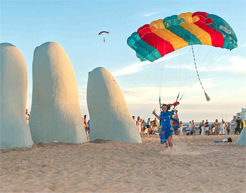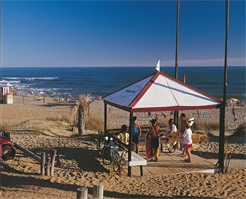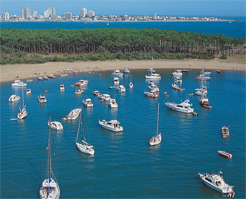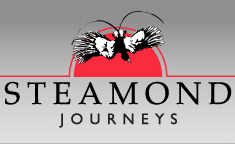Uruguay Travel Guide



Telephone:
E:
Area
Area total: 176,215 sq km
Land: 175,015 sq km
Water: 1,200 sq km
Buses
The Tres Cruces bus station is 2 km north-east of the centre. Being a relatively small country, Uruguay does not generally have separate systems of local and long-distance buses; most interurban buses will stop to pick up passengers who flag them down by the roadside. Standing passengers are allowed, but a point may come at which no more will be picked up. However, at busy times one departure will in fact consist of several buses leaving at the same time, some of which will omit stops at certain towns, as well as roadside pick-ups (check your ticket carefully to see which one you should be on). The bus number and destination are displayed in the front windscreen, often on a dot-matrix screen; middle-distance buses headed for Montevideo may show 'XXX' to represent Montevideo's Tres Cruces terminal, but longer-distance ones simply show 'Montevideo'. There are virtually no buses across the middle of the country -you'll almost always have to pass through Tres Cruces.
Buses are comfortable vehicles with reclining seats (Uruguayans do love to recline their seats at once, and as far back as possible) and good ventilation or air conditioning. There are no bed buses except on international services. They stick to a maximum of 90km/h, but given the country's straight open roads they manage pretty creditable average speeds. It's often worth booking in advance, especially if you want to go to Punta del Este on a Friday afternoon. If the bus terminal is on the outskirts of town, bus companies will usually have a ticket office downtown. You'll be offered a choice of seats, or perhaps standing space (no cheaper) if the departure is full. Some companies have decent websites, but there's no online booking.
The driver's assistant handles money, tickets and baggage; he (never she) will usually tag your bags - keep the counterfoil to be checked when you get off. At larger terminals a baggage handler may load your bags - if you offer a tip it'll be assumed you are an Argentine tourist. A small departure fee is charged only at shared municipal terminals, as in Montevideo, Punta del Este and Mercedes; elsewhere buses usually leave from the company's own offices. These offices usually have basic toilets (take your own paper) and let you leave baggage for an hour or two; at larger terminals toilets will be better, and usually free, but you will have to pay to leave baggage.
Car Rental
The major international car rental chains are easily found, especially in Montevideo and Punta del Este, as well as good local companies which may well be cheaper. You'll need only a valid driving licence from your home country. A compact car with manual transmission will probably cost about US$40 a day or US$200 a week outside peak season, with unlimited mileage included, and also child seats if required. Automatics are rarer and much more expensive. Most companies offer a good range of vehicles from compacts to minibuses. There are no one-way rentals except occasionally between Montevideo, Colonia and Punta del Este.
Climate
Mild year round averaging:
• in Winter (June to Sept.) 12°C
• in Spring (Sept. to Dec.) 17°C
• in Summer (Dec. to March) 23°C
• in Fall (March to June) 18°C
Average annual rainfall – 1,000 mm
Cruise Ships
Getting there by boat
Buquebus: Arrival at Rambla Portuaria de Montevideo (Montevideo Port) - Montevideo's port is about 1.5km (1 mile) from downtown.
Port Facilities
You will find a bank, exchange bureau, car hire desks, ATM, bar and restaurant, post office, chemist and left luggage facilities in Montevideo Port alongside good duty-free shop. Transport to the City: a taxi or remise takes around 30 minutes and the estimated cost port-hotel and vice versa is of USD 25-30.
Customs & Immigration
Citizens of most countries (exept China, India, Russia and few smaller countries) require only a passport for visits of up to three months to Uruguay. The same usually applies to Australians (although there was a hiatus in mid-2007 when an agreement lapsed and visas were required for a while).
If you wish to extend your stay for a further three months, contact the Dirección Nacional de Migración (National Office of Migration, Montevideo - in Spanish only) or in departmental capitals - but it's generally easier to leave the country for a night and return. If you wish to settle in Uruguay, contact the Inspectoría de Migración, although it's really better to discuss this first with the Uruguayan embassy in your home country.
Arriving by plane, you'll be given two forms, for Immigration and Customs; they are currently in Spanish only but are not difficult to fill in (just remember that your “apellido” is your family name). You'll be given a white form to keep with your passport, but if this gets lost it shouldn't be a problem as long as you have the correct stamp in your passport. Immigration queues are dealt with pretty fast, and there are special desks for disabled and pregnant people and those with babies.
On departure, if you are charged for overstaying, be sure to get a receipt.
Dress
Uruguayans dress conservatively and seldom wear the bright colors popular elsewhere in South America. Women may not wear nylons during the summer. If your Uruguayan colleagues do not wear ties or jackets in the summer, you may follow. For business, men should wear conservative, dark suits and ties. Women should wear blouses with dark suits, skirts and dresses.
Drink
The best bottled soft drinks are the Paso de los Toros line, produced in the town of the same name. Virtually all cafés and restaurants also offer native herbal teas such as boldo and manzanilla; you may also find other “yuyos medicinales”, infusions of herbs such as malva (mallow) and márcela (Achyrocline satureoides, A flaccida), which is something like camomile, taken as a tea for digestive, gastrointestinal or menstrual disorders and as a sedative. Marcela is also said to be rich in antioxidants, so is more popular than ever, also being used in handcreams, for instance.
Uruguay's national drink (even more so than Argentina's) is, of course “mate”, the infusión of the leaves of Ilex paraguariensis, a shrub of the holly family.
Uruguayan wine can be excellent and almost any restaurant will serve something decent. While it's red wine you need to go with steak, white wine is very popular, and is also served with orange juice (as sangría) and with apples, grapes and perhaps melón or pineapple (as clericó). Grappa (brandy) can be quite strong but is made much smoother with the addition of honey, the result being known as grappamiel.
Beer is of course widely available - chopp means draught, but generally refers to the basic lager-style beer, even if it comes in a bottle. Amber (or red) and dark beers may also be available. The most widely available beer is Pilsen (brewed in Montevideo since 1866), but it's usually possible to find the rather better Patricia (both are now owned by the global giant InBev), which comes in dark (negra) or light (común) varieties. Zillertal is another premium beer, harder to find and much more expensive than Patricia. The country's only craft beer or real ale is Mastra, which comes in Golden, Scotch Red Ale and Stout varieties, and is only found in a very few bars and upmarket supermarkets such as Tienda Inglesa.
Eating Out
Uruguayan national dishes are built around beef, mixed salads and wine, but Italian pasta is also very popular. Although lunch for the average Uruguayan means a good piece of red meat, any of the sidewalk cafes (bar), will serve you an excellent steak sandwich (slices of meat, lettuce, tomato, egg, etc.) known as Chivito Canadiense (Uruguayan steak burger), grilled ham and cheese (“sandwich caliente”), or tuna fish or Olímpico (similar to club sandwich). The most typical Uruguayan restaurant is the Parrillada (grills). Asado (barbecued beef) is popular, where the main cuts grilled are: steaks (costillas), fillet steak (lomo), ribs (asado de tira), sausages, chicken. Milanesas (veal cutlets) are also popular. The sausages are very good and spicy (chorizos, morcillas, salchichas). Morcilla dulce, a sweet black sausage has been highly praised, so has the morcilla salad, which is savoury. Chicken and pork are also popular and there is a selection of fish available year-round. Pastries are very good. Popular sweets: crystallized egg-yolks, known as yemas. Ice cream is excellent almost everywhere. Lunch is served in restaurants between 12 p.m. to 2:30 p.m. Dinner is generally late and local people usually wait until 9 or 10 p.m. Tea is also served between 5 to 7 p.m.
Electrical Current
220-Volt, 50 Cycles/sec.
Guide Books
BRADT GUIDE by Tim Burford – www.bradtguides.com
Health & Insurance
Uruguay is a clean temperate country with very few nasty diseases or health risks, and a good standard of health care. There is normally no rabies or malaria, and at the moment no dengue fever, although in early 2009 Argentina's health ministry belatedly admitted an outbreak affecting up to 15,000 people in Chaco and other northern states. Cities such as Paysandú are working hard to eliminate the Aedes aegypti mosquito, which carries the dengue virus; you should in any case take precautions against mosquito bites in the daytime. Similarly, yellow fever is found in Argentina's Misiones and Corrientes states and in adjacent parts of Brazil, but not as yet in Uruguay. It is recommended to have a yellow fever vaccination at least ten days before visiting the subtropical forests of Argentina and Brazil. The vaccine is not suitable for everyone, so ensure that you seek medical advice before booking your trip if you wish to stray outside of Uruguay. If you are coming from a yellow fever endemic zone into Uruguay then they will ask for a certificate. If you cannot have the vaccine for medical reasons then ensure that you obtain an exemption certificate from your GP or a travel clinic.
Apart from yellow fever, as described opposite, no other vaccinations are required, but make sure you're up to date with tetanus and diphtheria (which now come together with polio as the all-in-one Revaxis) and hepatitis A jabs.
Language
Spanish is the official language of Uruguay.
Media
There are over 20 television channels (including the state-owned TV Nacional Uruguay), with many more available on cable, and over 100 radio stations (including the state-owned Radiodifusión Nacional SODRE). The main Montevideo daily newspapers are El País, El Observador and La República, all of a decent standard. Freedom of speech is well established; although laws against 'insulting the state' are still on the statute book, they are effectively out of use.
Money
The local currency unit is the PESO URUGUAYO. Notes of 5, 10, 20, 50, 100, 200, 500, 1000 and 2000, PESOS, coins of 1, 2, 5 and 10.
Banks & Credit Cards
Travellers Checks are only accepted by Banks, hotels, and selected shops, as well as the widely recognised credit cards Diners, Visa, MasterCard, American Express.
Normal banking hours are Mon. to Fri. 1300 to 1700. If you wish to exchange foreign currency you will obtain better prices at the "Cambios", located everywhere.
Population
Population, Uruguay - 3,300,000
Population, Montevideo - 1,303,942 (metropolitan area)
Public Holidays
• January 01: New Year's Day
• May 01: Labor Day
• July 18: Constitution Day
• August 25: Independence Day
• December 25: Christmas Day (Catholic)
Taxis
There are plenty of black-and-yellow taxis, either waiting at street corners or cruising, with reliable meters producing a figure that needs to be decoded from a laminated price sheet. Taxis are safe and affordable (though fares are higher late at night and at weekends); the only time you might want to agree the fare in advance is when heading for the airport. There's no need to tip, but rounding up a little bit is appreciated.
To call a taxi, phone Radio Taxi 141 (\141), Radio Taxi Cooperativa (\2 311 1030), Radio Taxi Scot (\2 208 0810) or Fono Taxi (\2 203 7000).
It's also possible to book a remise (car with driver), for day tours or a cheaper transfer to the airport - companies include:
• Remises Montevideo (San José 1226 bis; \ 2 902 8844, 2 900 0015; 24hr mobile 9962 8725;
e-mail remis@adinet.com.uy),
• Independencia Remises (Colonia 807; \ 2 902 6766), Remises Carrasco (\ 2 606 1412; 24hr mobile 9440 5473; e-mail info@remisescarrasco.com.uy; www.remisescarrasco.com.uy).
• Remises La Española (\ 2 622 2323),
• Remises Pocitos (26 de Marzo 1269; \ 2 707 1807)
• Remises Tres Cruces (\ 2 401 8241).
Remises charge around US$10-12 per hour, or a little more if booked through a hotel or if going outside Montevideo department.
Telephone Services
Mobile Phones
Antel provides mobile phone (cellphone) service through its Ancel brand, but it has been overtaken by Movistar (owned by the Spanish company Telefónica) which now has more customers, and slightly better coverage of the country. You can bring a tri-band GSM phone, or put your own SIM card into a local handset; if you bring in a phone you must register it with Customs (Aduana) on arrival, for a fee of US$6, which will then allow you to buy an Uruguayan SIM card and credit.
History
The Portuguese founded the Montevideo area in the 17th century. The Spanish chased the Portuguese out of a fort in the area in 1724. Then, Bruno Mauricio de Zabala – governor of Buenos Aires – founded the city on December 24, 1726. In 1828, the Montevideo became the capital of Uruguay.
The city fell under British influence from the early 19th century until the early 20th century as a way to circumvent Argentine and Brazilian commercial control. It was repeatedly besieged by Argentinean dictator Juan Manuel de Rosas between 1838 and 1851.
During World War II, a famous incident involving the German pocket battleship Admiral Graf Spee took place in Montevideo, which was a neutral port during the war. After the Battle of the River Plate with the British navy on December 13, 1939, the Graf Spee retreated to the port.
Unlike its more well-known neighbours, Buenos Aires, Argentina, Montevideo is blessed with a natural harbour.
Shopping
Montevideo is perfect for leather lovers. Find great values on excellent quality jackets, skirts, pants, coats, handbags, wallets and belts in calf, antelope, suede and sheepskin leather.
Tipping
Normally all hotel and restaurant bills include a percentage service charge plus 23% value-added tax (I.V.A.), but an additional tip is expected. It is customary to tip around 10% in restaurants. Tips (known locally as "propinas") are also given to porters, theatre ushers, waiters and hairdressers. For taxi rides the practice is just to round off the amount to be paid.
Security
In general, Uruguay presents no real problems of security. However, an important recommendation is to take care of belongings such as purses, cameras, especially in the street and to carry a photocopy of your passport and keep the original in a safe place.
Culture
Opera, dance and concerts can be seen at Teatro Solís www.teatrosolis.org.uy Auditorio del Sodreputs on an eclectic range of concerts, films and modern ballet performances. Theatre and comedy can be seen at Comedia Nacional OrquestaFilarmónica de Montevideo is the city’s philharmonic Orchestra Drummers and dancers of Candombe (an African/Uruguayan rhythm) can be seen in Barrio Sur Barrio Sur. There are many options of museums, here we recommend some: Museums
One note concerning museums in Montevideo, they are free – but they also have an array of opening hours.
Getting there by air
Carrasco International Airport (MVD)
Montevideo’s main airport is 19 km (11 miles) east of the city centre.
Airport Facilities
You will find a bank, exchange bureau, car hire desks, ATM, bar and restaurant, post office, chemist and left luggage facilities in the airport alongside good duty-free shop. Transport to the City: a taxi or remise takes around 30 minutes and the estimated cost airport-hotel and vice versa is of USD 30-35. There are also three bus companies running regular services into the city centre, at a cost of USD 1 (to be paid in Uruguayan Pesos).
